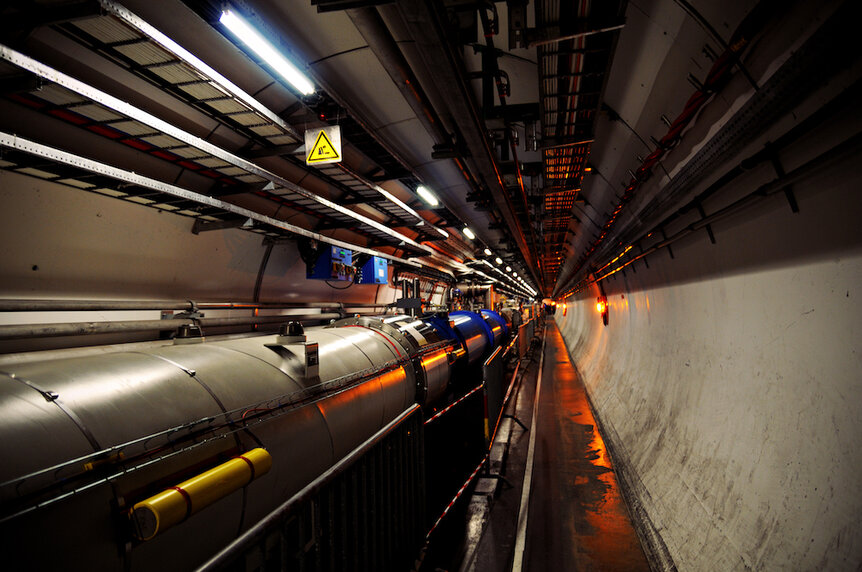Create a free profile to get unlimited access to exclusive videos, sweepstakes, and more!
What are proton packs and how do they work? The science behind 'Ghostbusters'
Back-mounted nuclear devices are not recommended.

The '80s were a weird time. The cold war was a constant low-boiling background presence, Nintendo had revitalized the video game industry, people were making mixtapes, and everyone was wearing neon. It was pure bedlam. The new millennium was coming fast, and no one knew what was going to happen, but we did know one thing: When there was something strange in your neighborhood, you called the Ghostbusters.
The titular busters were the four guys least likely to be heroes, armed only with their comedic charms and an array of spectacularly schlocky sci-fi gadgets, the most iconic of which was the proton pack. This back-mounted particle accelerator shot a beam of protons to trap the negatively charged specters and hold them in its grip, awaiting imprisonment inside a ghost trap.
Ethical questions of holding sentient beings inside an unregulated techno-prison aside, one wonders how these miniaturized marvels of science work.
REAL-WORLD PROTON PACKS (SORT OF)
The proton pack is a nuclear-powered backpack capable of accelerating a stream of protons inside the body of the pack and shoot them out of the Particle Thrower at its end. It accomplishes this through a cyclotron (or in the case of the 2016 reboot, a synchrotron).
Cyclotrons work by accelerating particles from the center of the device, outward along a semicircular path by way of a magnetic field. Two D-shaped hollow electrodes are placed back-to-back to create a circle with a gap between. Particles begin along one hollow electrode and when they reach the end, the polarity of the field is flipped, and they can travel along a second hollow electrode. Each time they circle the array, they receive a kick which accelerates the particles to higher speeds. Eventually they're expelled from the accelerator and onto a target. In this case, that target is presumably inside the particle thrower.
In a cyclotron, achieving consistent acceleration required the field to be flipped continuously as the particles moved around the electrodes. Because of relativistic effects of the particles (increasing in mass as they approach the speed of light) cyclotrons had innate limitations as to the energies they were able to achieve because of the constant nature of the electric and magnetic fields. Simply put, once particles reached a certain speed, they would hit the switching point during a time when the field would slow them down, rather than continue accelerating.
Synchrotrons are capable of reaching much higher energies because their fields are variable, and capable of remaining in line with the requirements of accelerating particles. While cyclotrons are still in use for some scientific and medical applications, synchrotrons are the preferred method for most large-scale particle accelerators because of their increased capabilities.
The most powerful particle accelerator in the world is the Large Hadron Collider (LHC) beneath the border between France and Switzerland. It took ten years to build and lies inside 27 kilometers (17 miles) of tunnels hundreds of feet underground.
It works by firing two beams of particles toward one another. Those beams travel at near the speed of light and are guided around the ring by massive magnets. In order to keep the magnets in working order, they are super-chilled to -271.3 degrees Celsius (-456.34 degrees Fahrenheit) less than two degrees above absolute zero.
Large magnets, 15 meters in length, bend the particle streams as they race around the accelerator, while hundreds of other magnets 5 to 7 meters long focus the beams. Finally, magnets squeeze the beam tightly together in order to maximize the chance that particles will collide when the two beams come together.
While the proton packs use a nuclear source, the LHC gets its protons by injecting hydrogen gas into a metal cylinder called the duoplasmatron (a name which would make Spengler proud) which breaks the gas down to protons and electrons awaiting to be accelerated.
The LHC is as big as it is on purpose (as is often the way with scientific experiments), as particles curve around an accelerator, some of their energy is lost in the form of radiation. By making the accelerator very large, those curves aren't as sharp and higher energies can be achieved. A ghostbusting scientist could get around this particular limitation by designing a linear accelerator without any curves, but the length would need to be huge in order to get the particles up to an appropriate speed. Doesn't work very well for a backpack.
COULD YOU BUILD ONE ON A BACKPACK?
The short answer is maybe. Certainly, cyclotrons exist in small enough dimensions to be worn on the back. In fact, that very first cyclotron built by Ernest Lawrence and Stanley Livingston in 1930 was only 11 centimeters (4.5 inches) in diameter.
CERN has been working on moderately small, yet still powerful cyclotrons for use in hospitals and scientists have even made a cyclotron as small as 8 centimeters across. The question becomes one of energy needs.
A smaller cyclotron (or synchrotron) is necessarily limited by how aggressive its curves are. Keeping the particles inside the path as they accelerate then requires all of the things the LHC has — powerful electromagnets and cooling systems — to keep the whole thing moving.
You could absolutely accelerate particles on your back (though we don't recommend it) but you might not reach the energy requirements needed to capture ghosts. That depends entirely on how negatively energetic ghosts are, and the Ghostbusters shockingly didn't return our call.
The good news is, while there are challenges to building a proton pack, there are also some elements of the real-world that would make the whole endeavor safer.
Particles leaving an accelerator exit along a straight line and continue along that line unless acted on by an outside force. That's the whole reason accelerators need magnets in the first place. So they'd be moderately easy to aim and you wouldn't have to worry so much about crossing streams and obliterating yourself. And if you did cross the streams, you wouldn't need to worry about wiping out all life as you know it. After all, crossing the streams is precisely what scientists at the LHC and other accelerators are doing on purpose to probe the secrets of the universe.
Egon really should have known better.
wa



























